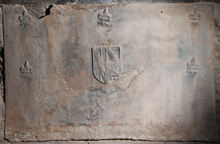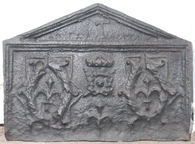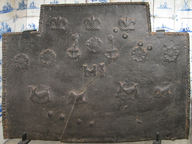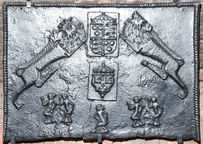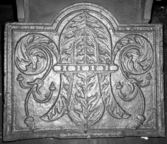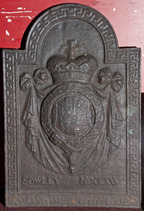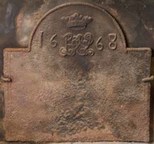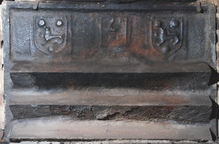-
951
Description: Rectangular; central shield; fleur-de-lys stamp repeated three times across top and once on each side level with shield, all regularly spaced.
Notes: It is likely that the arms relate to the marriage, in 1541, of Christopher Sackville (c.1519-1559), son of John Sackville of Chiddingly, Sussex, and Constance Colepeper, daughter of Thomas Colepeper of Bedgebury, Kent, one of whose ancestors was the heiress, Elizabeth Hardreshull. The blazon: Sackville - quarterly or and gules, a bend vair; Colepeper - argent a bend engrailed gules; Hardreshull - argent a chevron sable between nine martlets gules, six and three. Christopher Sackville's brother, Sir Richard, owned Horsted Keynes furnace, which may have been where this fireback was cast. A candidate for the earliest English fireback with an example of personal arms.
Arms: Sackville impaling Colepeper and Hardreshall
- Decoration tags:
- rectangular (shape)
- none (edging)
- carved stamps
- heraldic
- armorial
Manufactured: in the mid-16th century possibly at Horsted Keynes Furnace in the Weald area of England.
Current location: in private hands, Horsted Keynes, West Sussex, England.
- Attached to series:
- Personal armorial firebacks
- Sackville firebacks
-
1126
Description: Canted rectangular shape; twisted rope edging (top and sides); cavetto-moulded-edged rectangle top centre, enclosing date between initials CT; five shields of Ayloffe impaling Sulyard in two rows (3-2); Ayloffe: sable, a lion rampant Or, collared gules, between three crosses formy of the second; Sulyard: argent, a chevron gules between three pheons inverted sable.
Notes: William Ayloffe (c1535-1584) of Bretons, Hornchurch, Essex, Justice of the Court of Queen’s Bench, married (c1560) Jane, dau. of Sir Eustace Sulyard, of Runwell, Essex. The initials 'CT' are likely to be those of Charles Tyler, a founder whose working life and that of his family have strong parallels with the occurrence of these firebacks. The smallest dated example in this series.
Inscription: C.1.6.0.9.T
Arms: Ayloffe impaling Sulyard (William Ayloffe of Bretons, Hornchurch)
- Decoration tags:
- rectangular with canted top corners (shape)
- rope (edging)
- carved stamps
- individual letters
- individual numbers
- heraldic
- armorial
- text
Manufactured: in 1609 possibly at Bedgebury Furnace, Goudhurst in the Weald area of England.
Current location: The Crown Inn, The Green, Horsted Keynes, West Sussex, England.
- Attached to series:
- Ayloffe series
- Personal armorial firebacks
-
338
Description: Rectangular with pediment; ovolo moulded edging inside top of pediment and inside top and sides of rectangle; centre top, four-petal rose and crown with fleur de lys below; at either end, stamps made from two parts of a wreath (the middle section missing) enclosing a fleur de lys.
Notes: The wreaths from which the stamps have been disassembled can be seen complete on two other firebacks, and the rose and crown is a common stamp on a large series of early firebacks.
Inscription: ?I T
- Decoration tags:
- triangular arched (shape)
- ovolo (edging)
- carved stamps
- individual letters
- heraldic
- text
- objects
Manufactured: in the late-16th century in the Weald area of England.
Current location: in private hands Burford, Oxfordshire, England.
- Attached to series:
- Royal series
- Royal (wreath) series
-
942
Description: Rectangular with a central rectangular extension; twisted rope edging; fleur-de-lys stamp with twisted band repeated three times at top; ?rose stamp repeated five times in line below fleurs, some over pressed, central rose above others; cabled anchor stamp repeated twice, either side of central rose; initials below central rose; ?cow and dog stamps each repeated twice alternately in line below initials; eight rivets from later repair.
Notes: None of the stamps is known from any other fireback; cabled anchor may suggest a connection with a seaport.
Inscription: HI
- Decoration tags:
- rectangular with square arch (shape)
- rope (edging)
- simple stamps
- carved stamps
- individual letters
- heraldic
- text
- animals
- plants
- objects
Manufactured: in the early-17th century in England.
Current location: Wilberforce House, High Street, Kingston upon Hull, Yorkshire, England.
(part of the Hull Museums museum group)
- Attached to series:
- Miscellaneous stamp firebacks
-
345
Description: Rectangular; twisted rope edging (top and sides); from top, crowned Tudor royal shield (stamp overpressed) above crowned shield bearing initials, KH in Lombardic lettering, above a fleur de lys (stamp overpressed); to left, diagonal lion passant guardant sinister; to right, diagonal lion passant; at base, single 'imp' figure, arms to side, moving left but facing right, between two pairs of 'imp' figures (separately stamped), one moving left, right arm raised, the other moving right, right arm raised.
Notes: One of the 'Royal' series.
Arms: Tudor royal arms of England
- Decoration tags:
- rectangular (shape)
- rope (edging)
- carved stamps
- heraldic
- armorial
- animals
- humans
Manufactured: in the mid-16th century in the Weald area of England.
Current location: Ightham Mote, Ightham, Kent, England.
Museum number: 825393 (part of the National Trust museum group)
- Attached to series:
- Royal series
-
352
Description: Arched rectangular shape; cyma curve and astragal edging; fleur de lys formed from acanthus leaves within a circlet, between swirled, budded fronds, all in bas-relief.
Notes: An uncommon English fireback with a purely floral design.
Copies of this fireback are known.
- Decoration tags:
- rectangular with round arch (shape)
- cyma curve and astragal (edging)
- whole carved pattern
- heraldic
- plants
Manufactured: in the mid-17th century in England.
Current location: Christchurch Mansion, Ipswich, Suffolk, England.
(part of the Colchester & Ipswich Museums Service museum group)
- Attached to series:
- Miscellaneous pattern firebacks
-
1108
Description: Arched rectangular shape; Greek Key border with fillet edges; in high relief, in front of swagged drapery, the shield of, quarterly, France quartering England, Scotland and Ireland, surrounded by a Garter, and surmounted by a ducal coronet; below, the inscription in capitals.
Notes: The use of the Greek Key design as a border is believed to be unique for an English fireback. Although somewhat indistinct, the use of the Stuart royal arms and the ducal coronet can be explained by the fact that the fireback was one of a group cast for the 2nd Duke of Richmond, whose father, the 1st duke, was the illegitimate son of Charles II and Louise de Kéroualle. The Richmond arms were differenced from the Stuart royal arms by the addition of a bordure compony (the detail of which is not distinct on this casting). Sowley Furnace, near Beaulieu in Hampshire, was owned in 1732 by John, 2nd Duke of Montagu, and was let to Miles Troughton. Similar, but larger, variants of this fireback are at Goodwood House, the seat of the Dukes of Richmond, where this fireback is likely to have once been. Criterion Auctions, Islington, 7 Jan 2019, lot 128 (£50).
Inscription: HONI SOIT QUI MAL Y PENSE / SOWLEY MDCCXXXII
Arms: Duke of Richmond
- Decoration tags:
- rectangular with round arch (shape)
- fillet (edging)
- carved pattern panels
- heraldic
- armorial
- royal
- text
Manufactured: in 1732 at Sowley Furnace, Beaulieu in the New Forest area of England.
Current location: not known.
-
994
Description: Arched; cavetto-moulded edging; English royal Stuart shield, garter, crown, supporters, and motto on a cartouche; a monogram of S and C lies to the left of the Garter buckle; a small rose stamp is repeated each side of crown; date split each side of top of crown.
Notes: Although English arms, the design is in a continental style, arched firebacks being typical of Lorraine. In some later recastings the proportions have been distorted, making them narrower, and the '16' of the date is missing. The fireback illustrated was formerly in the city museum of Vlissingen in the Netherlands.
Copies of this fireback are known.
Inscription: 16 21 / HONI SOIT QVI MAL I PENSE / SC / DIEV ET MON DROIT
Arms: English Stuart royal (James I)
- Decoration tags:
- rounded arched (shape)
- cavetto (edging)
- whole carved pattern
- heraldic
- monogram
- armorial
- royal
- text
Manufactured: in 1621 possibly in the Ardennes area of Belgium.
Current location: not known.
Citation: Gardner, J. S., 1898, 'Iron Casting in the Weald', Archaeologia, 56, 1, pp. 133-164.
- Attached to series:
- Jacobean royal armorial firebacks
- Stuart royal armorial firebacks
-
1225
Description: Arched rectangular shape; twisted rope edging (top and sides); in arch, marquess's coronet above a monogram with date split either side.
Notes: The elaborate monogram has not been deciphered, but the fireback does not appear to be related to the Talbot family who owned Lacock throughout the 17th century.
Inscription: 16 [undeciphered monogram] 68
- Decoration tags:
- rectangular with round arch (shape)
- rope (edging)
- whole carved pattern
- individual numbers
- heraldic
- monogram
- text
Manufactured: in 1668 in England.
Current location: Lackock Abbey, Lacock, Wiltshire, England.
Museum number: 996713 (part of the National Trust museum group)
- Attached to series:
- Miscellaneous pattern firebacks
-
359
Description: Rectangular; double fillet moulded edging; top centre, shield-shaped block with a rectangle containing the crest of the Fowles - an Arm in armour holding a Battle axe issuant from a Ducal Coronet, above the initials, WF; top left and right, two shields of the arms of the Fowle family - (Gules) a lion passant guardant between three roses (Or); across the lower half of the fireback are three solid triangular prisms of iron.
Notes: The stamps relate to William Fowle (1568-1634), ironmaster of Riverhall furnace. The stamps also appear on grave slabs in Wadhurst and Frant churches and on an unprovenanced graveslab in Maidstone Museum. The iron prisms were included, perhaps, to retain heat and to prevent the fireback from cracking.
Inscription: WF
Arms: William Fowle, of Frant and Wadhurst
- Decoration tags:
- rectangular (shape)
- fillet (edging)
- carved stamps
- heraldic
- armorial
- text
Manufactured: in the early-17th century probably at Riverhall Furnace, Wadhurst in the Weald area of England.
Current location: in private hands, Lamberhurst, Kent, England.
- Attached to series:
- Fowle series
